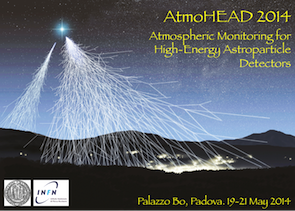Conveners
Instruments and Tecniques Developments
- Karim Louedec (LPSC, CNRS/IN2P3, UJF-INPG, Grenoble)
Instruments and Tecniques Developments
- Raquel de los Reyes (MPIK)
Ms
Guadalupe Saez Cano
(Space and Astroparticle Group, UAH, Madrid)
20/05/2014, 17:30
Oral
JEM-EUSO is a space-based telescope which will detect Ultra High Energy Cosmic Rays (UHECR) and Extremely High Energy Cosmic Rays (EHECR) using the atmosphere as a calorimeter. It will be located at the International Space Station (ISS), and will look down to the atmosphere. To estimate the energy and arrival direction of the UHECR & EHECR as well as its primary composition, the UV light...
Dr
Pacheco Briz
(Universidad Carlos III de Madrid)
20/05/2014, 17:55
Oral
Cloud information is extremely important to correctly interpret the JEM-EUSO telescope data since UV radiation coming from the Extensive Air Shower can be partially absorbed or reflected by clouds. In order to observe the atmosphere and clouds in the field of view of the UV telescope the JEM-EUSO system will include an atmospheric monitoring system, which consist of a LIDAR and an IR...
Dr
Mario Edoardo Bertaina
(TO)
20/05/2014, 18:20
Oral
The TurLab facility is a laboratory, equipped with a rotating tank, located at the Physics Department of the University of Torino.
It consists of a 5 m diameter tank, which is used for fluido-dynamics studies. The system has been thought mainly for studying problems where system rotation plays a key role in the fluid behaviour, for example in atmospheric and oceanic flows at different...
Dr
Pacheco Briz
(Universidad Carlos III de Madrid)
21/05/2014, 10:40
Oral
Clouds interact with the radiation propagating through the atmosphere absorbing, reflecting and transmitting part of the energy. This interaction may lead to misinterpretation of data retrieved from the radiation observed by JEM-EUSO UV telescope. At the same time the interaction cloud-ratiation can be used to retrieve cloud properties. JEM-EUSO Mission includes an Atmospheric Monitoring...
Dr
George Vasileiadis
(LUPM)
21/05/2014, 11:35
Oral
We present recent results obtained with the H.E.S.S. Lidar installed and operating for the last four years at the Namibian desert. Results obtained, using a recent Klett type analysis, permit a better correlation with relevant H.E.S.S. type related run parameters. Future plans as scenarios to implement these results on the main physics analysis chain will also be discussed.
Dr
Michael Daniel
(University of Liverpool)
21/05/2014, 11:55
Oral
The molecular atmosphere has a number of windows where it is effectively transparent to electromagnetic radiation, one of these being in the infrared 8-14 micron region. The presence of clouds and aerosols, which are more effective emitters of infrared radiation, in the atmosphere show up as an increase in the effective brightness temperature compared to the clear sky. This talk will cover the...
Dr
Petr Janecek
(Institute of Physics AS CR)
21/05/2014, 12:15
Oral
The Cherenkov Telescope Array (CTA) is a project to build a new generation ground-based gamma-ray observatory. Among other goals, the project aims to achieve high precision measurements of gamma-ray properties while maximizing the use of observation time. These objectives require detailed and fast information about atmospheric conditions, particularly the transparency (varying mostly with...
Mr
Dusan Mandat
(Institute of Physics Academy of Sciences of the Czech Republic)
21/05/2014, 12:35
Oral
The All-Sky-Camera (ASC) is a passive non-invasive imaging system for rapid night sky atmosphere monitoring.
The operation of the ASC will hence not disturb standard operation of the CTA telescopes, however results from the measurements will help to improve the accuracy and effective duty-cycle of the CTA observatory.
The goal of ASC, and recently developed intelligent image analysis...
Mr
Felix Jankowsky
(LSW)
21/05/2014, 14:30
Oral
The Automated Telescope for Optical Monitoring for H.E.S.S. (ATOM) is an optical 75cm telescope which operates fully automated. As there is no observer present during observation, an auxiliary all-sky camera serves as weather monitoring system. This device takes an 180° image of the whole sky every three minutes. The gathered data then undergoes live-analysis by performing astrometric...
Dr
Denys Malyshev
(ISDC)
21/05/2014, 15:05
Oral
Remote sensing of atmosphere is conventionally done via a study of extinction/scattering of light from natural (Sun, Moon) or artificial (laser) sources. Cherenkov emission from extensive air showers generated by cosmic rays provides one more natural light source distributed throughout the atmosphere. We show that Cherenkov light carries information on three-dimensional distribution of clouds...
Dr
Dorota Sobczynska
(University of Lodz)
21/05/2014, 15:30
Oral
The effective observation time with the Cherenkov telescopes arrays is limited to clear sky conditions due to considerable absorption of Cherenkov light by the possible presence of clouds. However below the cloud altitude the primary particles with high energies can still produce enough Cherenkov photons to allow detection by the large telescopes. In this paper, using the standard CORSIKA...
Dr
Johana Chirinos
(MTU)
21/05/2014, 15:55
Oral

